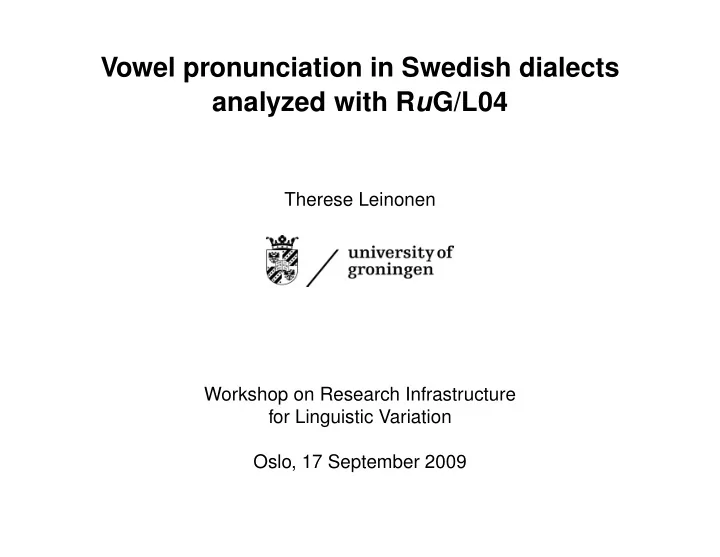

Vowel pronunciation in Swedish dialects analyzed with R u G/L04 Therese Leinonen Workshop on Research Infrastructure for Linguistic Variation Oslo, 17 September 2009
Outline • Introduction • Dialectometric research • Tools in R u G/L04 • Data • Acoustic analysis • Examples of analyses with R u G/L04
Introduction • R u G/L04: free software for dialectometrics and cartography • www.let.rug.nl/kleiweg/L04 • developed by Peter Kleiweg, University of Groningen • Unix, Windows • no graphical user interface, yet
Dialectometric research • dialectometry = measuring dialects • aims: finding dialect areas and describing dialect continuua • dialectometry emphasizes the aggregate analysis and is data-driven • statistical methods are used for classifying dialects and exploring dialect con- tinuua
Tools in R u G/L04 • dialectometric tools, distance measures based on transcribed dialect data: – Levenshtein distance (string edit distance) – Gewichteter Identitätswert • statistical tools: – hierarchical clustering – multidimensional scaling – R interface • cartography: – web tool for acquiring geographic data with Google Earth: data points and borders of the studied area – tools for displaying dialectometric results
Data • SweDia (swedia.ling.gu.se): project carried out by the universities of Lund, Stockholm and Umeå 1998-2001 • 105 sites in Sweden and Swedish-language parts of Finland • 12 speakers from each site: 3 elderly women, 3 elderly men, 3 young women, 3 young men • vowels elicited with existing mono- or bi-syllabic words with the target vowel in a coronal conson- ant context • 19 words of which the vowels cover the standard Swedish vowel space: dis, disk, dör, dörr, flytta, lass, lat, leta, lett, lott, lus, låt, lär, lös, nät, sot, särk, söt, typ
Acoustic analysis • Principal component analysis (PCA) of Bark-filtered vowel spectra (Pols et al., 1973; Jacobi, 2009) • two components used as acoustic measure of vowel quality, high correlation with formants • each vowel measured at nine points within every vowel segment (starting at 25 % and ending at 75 % of the vowel duration) • the linguistic distance per vowel between any two varieties is calculated as the Euclidean distance of the acoustic parameters • Euclidean distance, where i ranges over the nine sampling points: � 9 � (( PC 1 xi − PC 1 yi ) 2 + ( PC 2 xi − PC 2 yi ) 2 ) � � distance ( x, y ) = � i =1 • the distance between varieties is the average distance of the 19 vowels
R u G/L04: mapdiff • draws a map of differences between neighbors • darker lines indicate a larger differ- ence
Multidimensional scaling • method for visualizing and exploring similarities/dissimilarities in data • with given pair-wise distances positions in a low-dimensional space can be assigned to data points • 3 dimensions visualized in red, green and blue → maps where the language varieties form a continuum (Heeringa, 2004)
R u G/L04: maprgb
R u G/L04: maprgb older speakers younger speakers • significantly shorter distances between geographic varieties among younger speakers than between older speakers ( t (96) = 8 . 4 , p < 0 . 001 )
R u G/L04: maplink • for each pair of sites: measure the dis- tance of older and younger speakers sep- arately • distance ( older i , older j ) > distance ( younger i , younger j ) = convergence ( blue ) • distance ( older i , older j ) < distance ( younger i , younger j ) = divergence ( red ) • darker lines indicate larger differences
R u G/L04: maplink convergence divergence
R u G/L04: mapclust • displays groupings in data by using colors, patterns, numbers or sym- bols • groupings based on hierarchical clustering (R u G/L04) or manually indexed data 5 clusters using Ward’s method
R u G/L04: mapclust
Thanks to: Peter Kleiweg for making the software available: http://www.let.rug.nl/kleiweg/L04/ The SweDia project for making the data available The dialectometric research group in Groningen for comments and discussion YOU for listening! References: Bruce, G., Elert, C.-C., Engstrand, O. and Eriksson, A. (1999), Phonetics and phonology of the Swedish dialects: a project presentation and a database demonstrator, Proceedings of the 14th International Congress of Phonetic Sciences (ICPhS 99) , San Francisco, pp. 321–324. Heeringa, W. (2004), Measuring Dialect Pronunciation Differences using Levenshtein Distance , PhD thesis, Rijksuniversiteit Groningen. Jacobi, I. (2009), On Variation and Change in Diphthongs and Long Vowels of Spoken Dutch , PhD thesis, Universiteit van Amsterdam. Nerbonne, J. (2009), Data-driven dialectology, Language and Linguistics Compass 3 (1), 175–198. Pols, L. C. W., Tromp, H. R. C. and Plomp, R. (1973), Frequency analysis of Dutch vowels from 50 male speakers, Journal of the Acoustical Society of America 53 , 1093–1101. Tabachnik, B. G. and Fidell, L. S. (2007), Using Mulitvariate Statistics , 5th edn, Pearson.
Recommend
More recommend